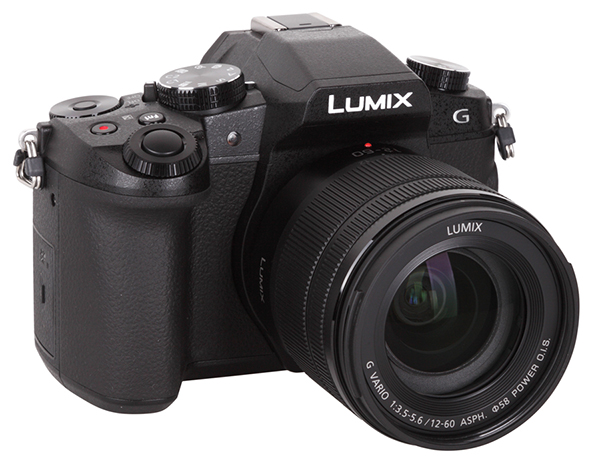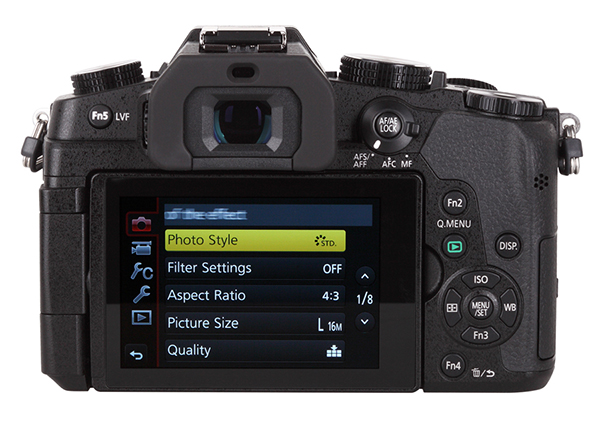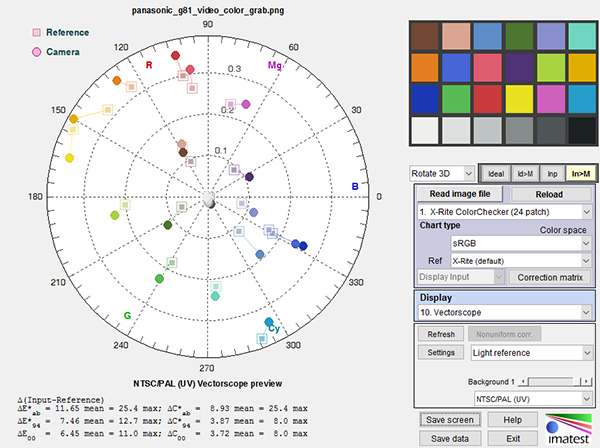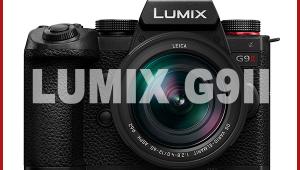Panasonic Lumix DMC-G85 Mirrorless Camera Review

(Editor's Note: Lab Review lab tests and comments are supplied by BetterNet, Shutterbug’s TIPA-affiliated testing lab and edited by George Schaub. Shutterbug is the sole US representative within TIPA, a worldwide association of photo and imaging magazines.)
The new Panasonic Lumix DMC-G85 is mirrorless camera built around on a 16MP Micro Four Thirds image sensor. The Panasonic G85 offers a brilliant electronic viewfinder based on OLED technology. This viewfinder is very large (0.74x; equivalent to a 35mm film camera with a 50mm lens) and offers a high resolution of 2.36 million RGB dots.
The EVF has an eye sensor, which means the view switches automatically to the EVF when the photographer looks into the viewfinder: alternately, the user can toggle view manually by pressing the “Fn5” button on the back. This function button is one of five user-definable “Fn” buttons on the top and on the back: the G85 also has five “virtual Fn” buttons on the LCD screen. The screen is touch sensitive and fully integrated into camera operation.




Camera Features, Layout & Performance
The Panasonic G85's LCD screen can also be used to define focus areas, set up the focus tracking point, change exposure parameters and for menu navigation. There’s also a standard 4 way control field and two setup dials on the top. These dials are arranged so the photographer can reach the first dial with the forefinger of the right hand and the second dial with the thumb of the right hand. In manual exposure mode, aperture and shutter speed can be set up simultaneously; they are also used for menu navigation. The combination of dials, control field, user definable “FN” buttons, touch screen, and “Q” (for quick) menu make for a very comfortable and intuitive handling experience.
A large top mode dial allows for the choice of exposure modes, including standard (P, S, A, M) and many scene programs and effects, as well as two user-definable modes. The swivel monitor is fully articulated: for safety purposes the front of the LCD can be rotated to the back of the body: this protects the glass front from dust and scratches. The body is sealed and weatherproof. During our tests the camera was used on a very rainy day with no ill effects.
The substantial body is based on a magnesium alloy chassis and has a built-in image stabilizer. It offers “Dual I.S.” functionality, which allows the user to combine the sensor shift stabilization system with the optical stabilizer systems of Panasonic’s “Power O.I.S.” system. The “Dual I.S.” system offers 5-axis-stabilization, claimed to yield stabilization up to 5 EV, a claim verified in our tests.
The new Panasonic offers “4K Photo” modes, which allows images made in burst mode with 4K resolution to be saved as an MP4 video stream. The user can extract one image of this stream as an 8MP image file. When taking pictures in “Post Focus” mode the camera will change focus setting while recording the video stream: thus, the user can choose the best image from the stream as a still image file.
It also offers additional “4K Photo” features: It can export of multiple images instead of one single image file when checking the recorded scene in playback mode; a new mode, called “Focus Stacking”, which will change focus settings throughout the “streaming” so the user can export an image file of their choosing that matches the desired focus settings. We found this very useful when shooting macro scenes. The drive controls on the camera are used to choose the 4K as well as standard modes like single shot or continuous shooting.
The camera offers a very fast and highly configurable AF system. Based on contrast metering, it allows for use of 49 AF areas plus “focus tracking” that follows moving objects in the scene. In manual focus mode the camera offers helpful features like a magnifier function and “focus peaking,” which marks contrast lines with colors when focus is achieved.

Comments on Image Quality:
Color: The white balance system of the Panasonic G85 showed typical behavior for Panasonic cameras. The darker and midrange neutral tones show a slight shift into the blue area of the color space; the brightest gray nuances show a shift into the yellowish area. Nevertheless, the aberrations are very small and the color is very realistic. Color aberrations are on a very low level: only the blue nuances are boosted. In some scenes the blue colors seem to glow. In most landscape scenes the blue sky is also boosted. Brighter skin tones show a little higher magenta/pink rate. Color differentiation is very good. Even in oversaturated blue colors the differences between darker and brighter areas are clearly visible.
Sharpness: The G85 achieves very high results in our resolution tests. The ISO 12233 chart was reproduced with 3268 of 3448 lines per picture height. But the result chart illustrates that the camera offers an intense sharpness filtering and contrast line enhancements, so the graph in “Edge profile: Horizontal” shows a very high bulge to the top, while the SFR line shows a flatter cure, but also a very high resolution result. The overshot effect is very high (more than 28 percent), an indication of intense sharpness filtering.

These effects are visible in images with very hard contrast lines although they are less noticeable in real life images. Fine structures in the test box image and the portrait shot are very natural and do not display the effects noted in the test chart.
Noise: Up to ISO 1600, images made by the Panasonic G85 are very clean and smooth. Color noise is very discreet and the luminance noise factor stays below the 1.0 percent line even in images taken at ISO 6400 setting. Up to ISO 12800, these filter settings are still acceptable, but at ISO 25,600 the blurring gets annoying and fine details become reduced; colors also become less saturated at ISO 25,600.
The dynamic range results are very good in the ISO 200 to ISO 800 range. The camera achieved a maximum of 11.2 f-stops and keeps a high level of about 10 f-stops in the ISO 200 to 1600/3200 range. At higher ISO settings the dynamic range results drop significantly, with a loss to 8.37 f-stops at ISO 25,600 mode.

Video Format and Handling
The Panasonic G85 offers sophisticated video capabilities. It is able to record 4K video with 3840x2160 pixels and 30 frames per second (progressive mode). In addition, it offers PAL compatible modes with 25 frames per second and a Blu-ray compatible mode with 24 frames per second. In Full HD mode it is able to record up to 50/60 frames per second with 1920x1080 pixels.
In Full HD mode videos can be recorded as an AVCHD 2.0 file with up to 24 Mbit/s. This is the standard file format for camcorders. For recording in 4K mode the photographer has to use the MP4 file format. In this mode the camera will record very high data rates, up to 100 Mbit/s, so a fast SDHC or SDXC card is recommended.
When using the Panasonic G85 in photo mode the user can start video recording at any time by pressing the small video recording button next to the shutter release button on the top. This will switch to video recording in automatic exposure mode. For recording videos with S, A or M setting the user has to switch the mode dial into the “film recording” position (icon of a small film camera with an M).
All video recording parameters in the Panasonic G85 can be set manually, including white balance, exposure settings and ISO speeds, which is limited to ISO 6400. In addition, the camera allows for use of some of its “effect filters” even when recording video.
The focus peaking system and the magnifier are very helpful for manual focusing. The stabilizer system of the camera helps record blur free and smooth video clips. The sound level can be controlled manually and there is a jack for an external microphone. In addition to its video capabilities the camera offers special “4K Photo” modes that combine video and photo shooting in a very unique way.

Comments on Video Quality
The Panasonic G85 performed very well in our video tests. In Full HD mode it reproduced the ISO 12233 chart with 866 of 1080 lines per picture height. In 4K mode it achieved 1544 of 2160 lines per picture height. 4K videos show a lot of details and have a really crisp look.
The color reproduction in video mode is very good. The white balance system shows identical results to photo mode: darker gray nuances are shifted into the blue direction while brighter have a slight yellowish touch. Color errors are on a very low level: only cyan shows a significant shift (less saturated than the given value). The results of the noise tests are very good. Luminance noise is very low; color noise isn’t visible up to ISO 3200. Just like in photo mode, the camera uses an intense anti noise filtering in video mode. Dynamic range results are a little ambivalent. At ISO 200 the camera achieved a maximum of 10.8 f-stops, which is very high. At ISO 400 and higher, the dynamic range drops to about 9 f-stops.
Pro:
+ Very good image quality (resolution, color reproduction)
+ Dual I.S. combines optical stabilization system
+ High resolution OLED view finder
+ Very fast AF system
+ Wi-Fi; touch and swivel LCD
+ High end video features
Con:
- Missing GPS system (Wi-fi connection and GPS data received by the phone are used for geotagging)
- Missing earphone jack for video recording
The Panasonic Lumix DMC-G85 sells for for $999.99 with a 12-60mm lens, and for $899.99 body only.
(Lab Review is where we publish web-exclusive lab reports on cameras. To read more Lab Reviews, click on the Reviews tab on the top navigation bar of this page. New photo gear reports are published frequently, so check Reviews for more equipment evaluations from Shutterbug writers.)
- Log in or register to post comments

















































